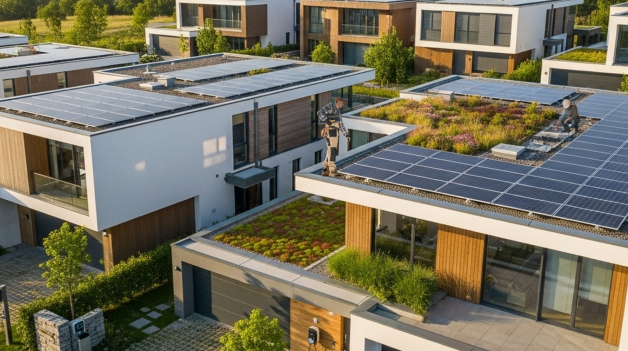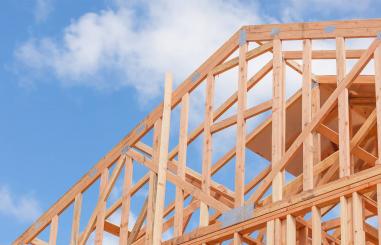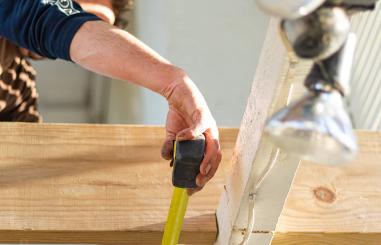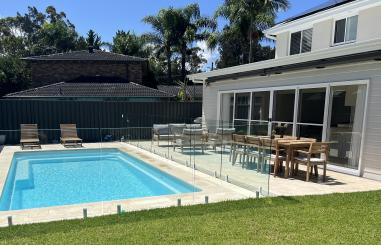Imagine building a project that not only looks good today, but keeps looking and saving for you for five, ten, or even twenty years down the track. That’s precisely what sustainable construction is all about. Whether you’re a sub-trade, an existing client, a future client or simply curious, this blog is for you. We’ll walk you through how going green (or let’s say “smart-green”) on your construction project can save money, improve outcomes and make life easier, all with a touch of humour (yes, we promise – we’re not just cement and concrete folks).
When we at Prescom pick materials, systems and processes, we often say: “Build it once, build it right, and let it pay you back.” Here’s how that works in simple steps:
Lower running costs – Think of insulation, energy-efficient lighting, and water-saving fixtures. They might cost a little more upfront, but they reduce your bills for years.
Less maintenance and replacement – Durable, sustainable materials often last longer (fewer repairs, less downtime).
Better value and resale appeal – If the building is thoughtfully constructed with sustainability in mind, it retains its value and attracts high-quality clients or tenants.
Regulation-compliance from the get-go – In New South Wales (NSW), for example, the State Environmental Planning Policy (Sustainable Buildings) 2022 (SEPP) encourages sustainable design. It sets minimum standards for energy, water and emissions.
At Prescom, we like to break things down into simple checkboxes so sub-trades, clients, and everyone know what to expect. Here’s our “how-to” list for a sustainable build:
Step 1: Begin at the design stage. Choose orientation, glazing, insulation, and passive solar where possible.
Step 2: Pick materials with care. Low-VOC paints, recycled steel or sustainably-sourced timber, locally sourced where possible to cut transport costs.
Step 3: Set up energy- and water-efficiency systems. Think LED lighting, efficient HVAC, rainwater harvesting, and low-flow fixtures.
Step 4: Efficient site management. Reduce construction waste, recycle what you can. In NSW, the Environmental Management Guidelines for Construction (Edition 4) set out how to do that for major projects.
Step 5: Monitor, maintain, review. Sustainable doesn’t mean “set-and-forget”. A little maintenance keeps those savings rolling.
As our Prescom mantra says: “Build smart today, benefit tomorrow.”
Did you know the Building Sustainability Index (BASIX) was introduced in NSW in 2004? It aimed to reduce water use and greenhouse emissions for homes.
Under the Sustainable Buildings SEPP (effective 1 October 2023), new non-residential buildings and extensive renovations must measure and report embodied emissions, minimise mains-supplied potable water and improve thermal performance.
A little humour: If your building leaves the lights on all night and the bill comes in like a shock, think of it as a “sustainability prank” you’re playing on your wallet. Maybe it’s time to turn the lamp off (or switch to LED).
If you’re ready to see how sustainable construction can save you real money long-term, and maybe even put a grin on your accountant’s face, give us a call. At Prescom Constructions, we’re ready to partner with you, show you options, and build something that works now and in future.
Contact us today, and let’s build smart, build sustainable, build together.
Remember: “Sustainability isn’t just green, it’s good business.”


Prime Costs (PC) and Provisional Sums (PS) are essential terms in construction quotes. Prime Costs cover allowances for materials like fixtures or appliances that haven't been selected yet, offering flexibility but potentially leading to additional costs if more expensive options are chosen. Provisional Sums are estimates for work not fully defined when quoting, like excavation or retaining walls, and may change due to unforeseen circumstances. Understanding the distinction helps homeowners manage budgets and avoid surprises during the building process.
Read more
A pre-handover inspection is crucial when taking possession of a new home to ensure any issues or defects are addressed before the final settlement. Key areas to check include the structural integrity (e.g., walls, floors), fittings and fixtures (e.g., taps, doors, windows), kitchen appliances, bathroom tiles and plumbing, electrical systems, and finishes like paintwork and flooring. By thoroughly inspecting these aspects, homeowners can prevent costly repairs later and ensure a smooth transition into their new home.
Read more
In recent years, a new trend has emerged in the world of residential homes known as the Australian Hamptons style. This unique architectural and interior design style combines elements of traditional Hamptons style with a distinctive Australian twist, resulting in homes that are both elegant and relaxed. Often referred to as Aussie Hamptons, these homes have gained popularity for their timeless appeal and seamless integration with the beachy Australian lifestyle.
Read more